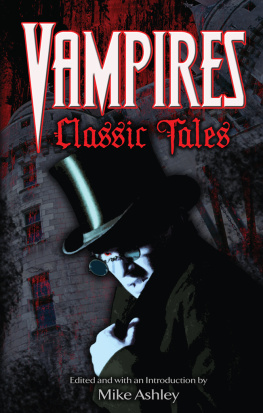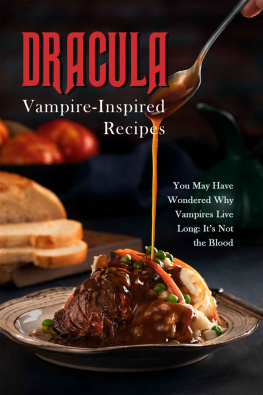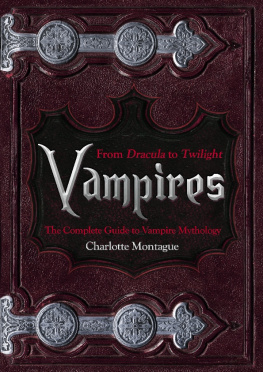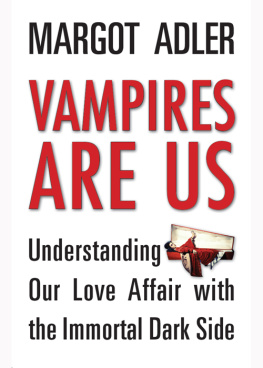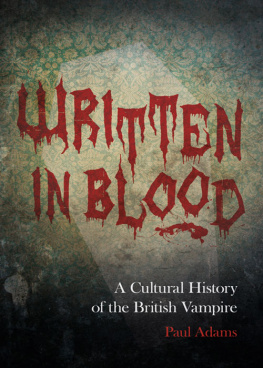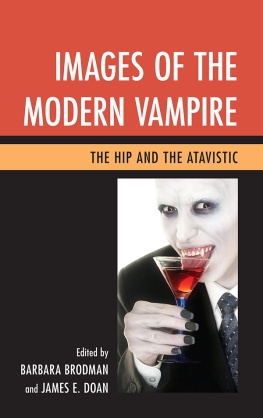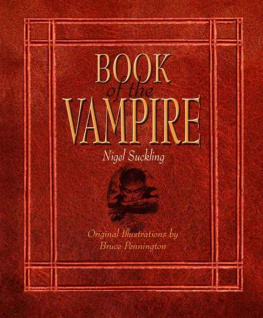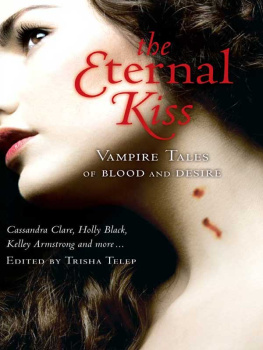V ampires Classic Tales
Edited and with an Introduction by
Mike Ashley
DOVER PUBLICATIONS, INC.
Mineola, New York
Acknowledgments
See
Copyright
Introduction and notes copyright 2011 by Mike Ashley
All rights reserved.
Bibliographical Note
Vampires: Classic Tales, first published by Dover Publications, Inc., in 2011, is a new anthology of twelve stories reprinted from standard texts. A new Introduction, written by Mike Ashley, has been specially prepared for the present edition.
Library of Congress Cataloging-in-Publication Data
Vampires: classic tales / edited and with an introduction by Mike Ashley.
p. cm.
Includes bibliographical references.
eISBN-13: 978-0-486-32103-5
1. VampiresFiction. 2. Horror tales, American. I. Ashley, Mike.
PS648.V35V295 2011
813'.54080375dc22
2010052827
Manufactured in the United States by Courier Corporation
48113101
www.doverpublications.com
Contents
Nancy Holder
Ernst Raupach
Karl von Wachsmann
Alexandre Dumas
Tanith Lee
Eliza Lynn Linton
Julian Osgood Field
R. Murray Gilchrist
Dick Donovan
Brian Stableford
Sidney Bertram
Lord Byron
INTRODUCTION
The Romance of Vampires
THIS BOOK CONTAINS a selection of vampire stories both old and new. Generally Ive reprinted lesser-known stories with an intent to show both the origins of the vampire in fiction and some of the diversity that has emerged over the years.
Vampire fiction has been with us for at least two hundred years and our fascination with it remains undiminished. If anything, it is at the height of its popularity. It is not difficult to see why, with the vampire so often portrayed as a tragic hero or, in the case of women, a voluptuous temptress or femme fatale.
The success of the topic in books in recent years can be traced to Anne Rices Interview with the Vampire (1976) and its sequels, and the theme was further popularized with the TV series Buffy the Vampire Slayer (19972003) and Stephenie Meyerss series that began with Twilight (2005). Between them, Rice and Meyerss books have sold over 200 million copies, which probably makes vampires the most widely read of all genre fiction.
And it owes all its success to Lord Byron.
Well, not quitebut he has a lot to answer for.
It barely needs repeating, but one of the most influential literary gatherings happened at the Villa Diodati on the shores of Lake Geneva in June 1816. Present were Byron and his personal physician, Dr. John Polidori, the young Mary Godwin and her future husband, the poet Percy Shelley, and Marys half-sister Claire Clairmont. During a storm they read from a collection of Gothic horror stories, Tales from the Dead, and Byron challenged each of them to write a ghost story. The most famous work to emerge from this was Mary Shelleys novel, Frankenstein. Byron and Percy Shelley soon gave up their efforts, but Byrons unfinished fragment was used by Polidori as the basis for his own story, The Vampyre, which was published in the New Monthly Magazine in April 1819. The publisher of the magazine, Henry Colburn, attributed the story to Byron, which vexed the poet, who refuted it in a letter published in The Times of London on June 5, 1819. I am not the author and never heard of the work in question until now, he wrote, adding, I have, besides, a personal dislike to vampires and the little acquaintance I have with them would by no means induce me to divulge their secrets.
By then Polidori had already proclaimed his authorship but for years the suspicion remained that it was by Byron. This was compounded by the fact that the name Polidori chose for the vampire, Lord Ruthven, had already been used by Lady Caroline Lamb in her novel Glenarvon (1816) and Ruthven was clearly based on Byron. Polidori likewise modeled his Ruthven on Byron, and it is from this story that the romantic yet tragic image of the vampire has grown.
Polidoris story is frequently reprinted in anthologies, so I have not included it here, but Byrons original is less readily available, so I have included that in an appendix because of its historical significance. Although Byron did not get as far as resurrecting his vampire, he was nevertheless seeking to write what is now regarded as the first modern fusion of the vampire myth and gothic tale in English fiction. And by completing the story, Polidori gave rise to the whole iconic vampire imagery of doomed nobility.
*
The idea of vampires, or at least demonic figures who devour flesh and blood, has been around for thousands of years. They appear in the legends and fables of ancient Egypt, Babylon, Greece, and Rome, where they are invariably female and called lamia. The Greek writer Phlegon, who lived at the time of the Emperor Hadrian in the second century, collected together a miscellany of stories and accounts of strange and inexplicable events known as On Marvels, and among them was the story of The Bride of Corinth about a young Athenian man who discovers his wife-to-be has risen from the dead. This story was the basis of the poem, The Bride of Corinth by Johann von Goethe, which appeared in 1797 at the height of the boom in Gothic literature.
But truth to tell, the idea of vampires was already so well entrenched in everyday parlance that it was possible to lampoon the idea as early as 1785. On October 18 that year the Universal Register (the fore runner of the London Times) ran an anonymous short story called Opulence, wherein the first person narrator assists an alchemist in creating the philosophers stone. The alchemist is killed, but the narrator takes the stone and with it becomes wealthy. However, his fortune attracts the interest of others who descend upon his estate and rob him of everything. He calls these thieves vampires, because they bled him dry of everything, a metaphor still used today. A footnote to the story explains:
In Poland and some other countries, a notion is entertained that some persons after they are dead and buried, have the power of sucking others till they die and to them they give the name vampire.
The Oxford English Dictionary notes that the word vampire had first appeared in print in England in 1734, so it was firmly in circulation by the time Polidoris story was published.
Soon after Polidoris story was published, another appeared in English, Wake Not the Dead, in the anthology Popular Tales and Romances of the Northern Nations, published in 1823. It appeared anonymously but for years was attributed to Johann Ludwig Tieck, despite there not being any original German text amongst Tiecks accredited work. In fact, it is now firmly established that the story was by Ernst Raupach and it appears here correctly attributed, and correctly titled as Let the Dead Rest for the first time. This was the first story to develop what has become the traditional vampire imagery of a beautiful, seductive creature that shuns daylight, weakens its victims, and can only be despatched with a dagger through the heart.
Also of historical importance is The Mysterious Stranger. Though first published in English in 1854, it had appeared in Germany at least ten years earlier and, as such, was the first vampire story to be set in the Carpathian mountains, the location of Draculas castle in Bram Stokers famous novel, which was published in May 1897. Although there is no evidence that Bram Stoker had read the story, there are sufficient similarities between it and Dracula for the antiquarian and ghost-story writer M. R. James to suggest that it must have served as the basis for the novel. For years the authorship of this story was treated as anonymous, but recent research has revealed that it was by the little-known German writer Karl von Wachsmann.
Next page
